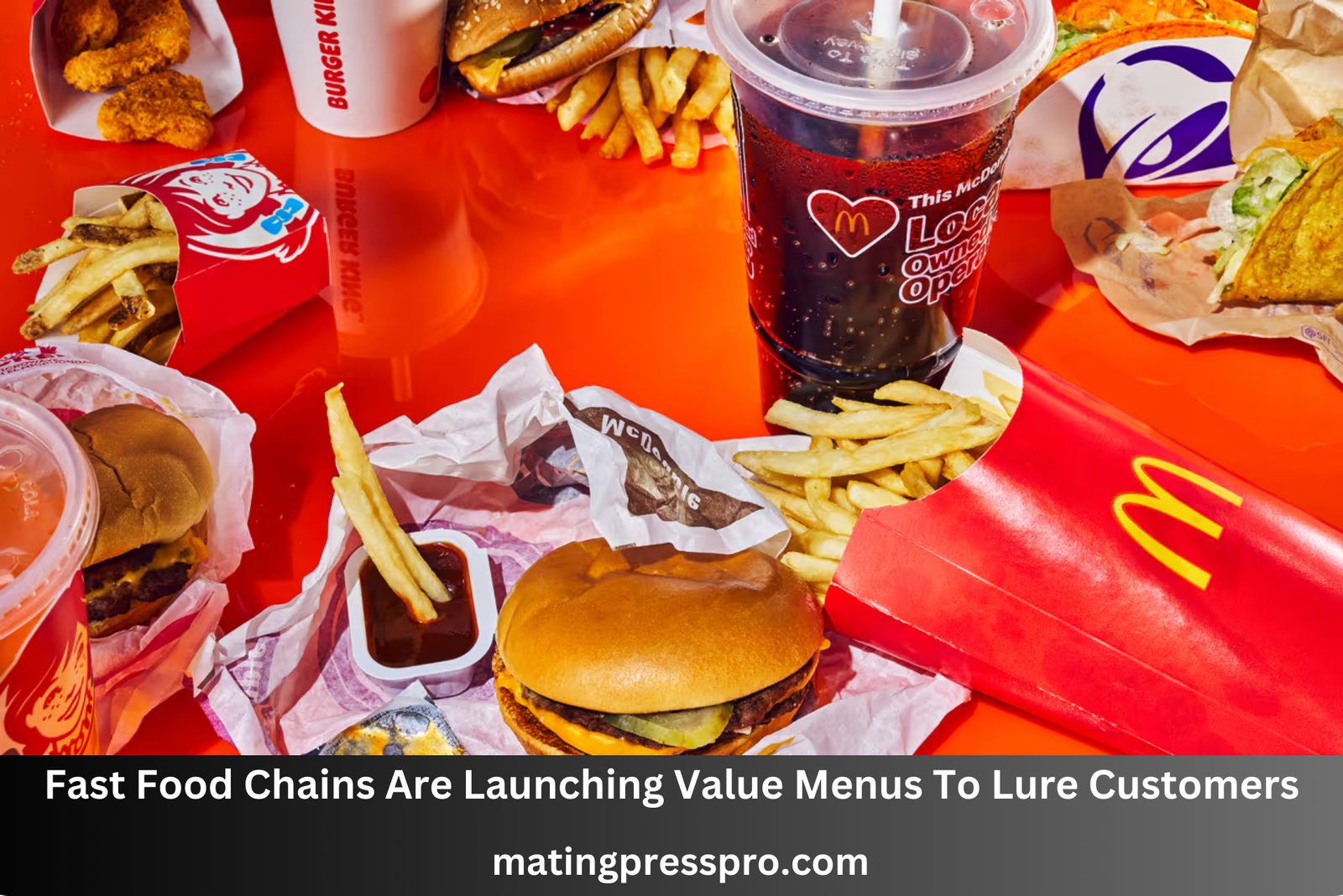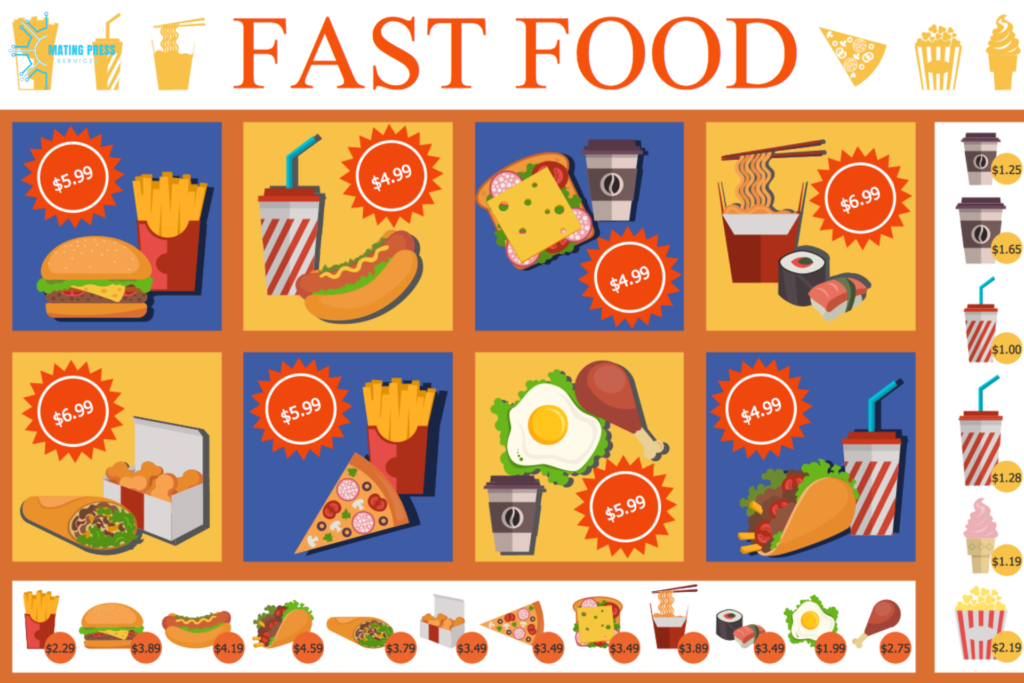Fast Food Chains Are Launching Value Menus To Lure Customers

Since quite some time, fast food restaurants have been key players in the global food industry as they serve quick, convenient and cost effective meals. In the recent past, there has been a major shift in the Fast Food Chains sector with one of the most noticeable being the introduction and expansion of value menus. These menus that are created to give customers a wide range of low-cost options have become a vital move for fast foods looking forward to attracting and retaining clients to their competitors in an environment characterized by high competition. This article highlights why value menus have gained prominence, their benefits and challenges as well as what lies ahead for this trend.
The Rise of Value Menus in Fast Food Chains

History and Evolution of Value Menus
The concept of value menus is not new in fast food chains. For several decades now, offering cheaper items that can attract price-conscious clientele has been in practice. Initially, value menus were much simpler showcasing only few basic items such as small burgers, fries and drinks among others. As at those days value menu was used by many firms during economic recessions or times when competition gets stiffer.
With an evolving Fast Food Chains industry came more sophisticated concepts such as value menu with time. Chains began expanding their offerings to cater for different preferences hence bringing on board various types of dishes preferred by different tastes. Currently there is greater variety on these menus than any other time before including traditional favorites and new innovative meals among others (Tayyab et al., 2016). This transformation indicates that consumer’s needs keeps shifting along with the company’s need always wanting to be ahead of its rivals.
Major Players Introducing Value Menus
Several big brands within this market space were influential towards popularizing value menus; McDonalds being one among them where it has long been at leading edge having its iconic Dollar Menu. It became exceedingly popular immediately after it was launched in early 2000s since it targeted at customers who wanted inexpensive meals. McDonald’s value menu has continued to undergo transformation over the years in line with the changing tastes of its customers hence introducing the new $1 $2 $3 Dollar Menu which provides for more options at various prices.
Another fast food chain that has achieved substantial progress in this regard is Taco Bell. The Cravings Value Menu priced at only a dollar is one of the most successful for them. This brand also introduced value boxes such as the $5 Cravings Box, which represents an all-in-one meal for an affordable price.
Similarly, Wendy’s has become a famous outlet because of its 4 for $4 deal. This assortment contains sandwich option plus 4 piece nuggets, small fries and a drink all priced at only four dollars. It is through such combinations of variety and value where Wendy’s has managed to differentiate itself from other players in this crowded Fast Food Chains market.
Why Fast Food Chains Are Adopting Value Menus
Economic Factors
The state of economy greatly influences adoption and success of value menus. When economic uncertainty prevails, consumers become highly sensitive to prices and thus look for cheaper places they can dine from. Fast Food Chains react to this by particularly emphasizing on their respective value menus that provide foods that are friendly to budgets without trading off convenience or taste.
For instance, the 2008 financial crisis witnessed a surge in value menus as consumers scrambled to get better deals for their money. Fast food chains which correctly marketed their value menus during this period could therefore attract many customers and consistently maintain sales amidst harsh economic circumstances.
Competitive Landscape
The Fast Food Chains industry is an intense market characterized by fierce competition among chains for market share. Value menus provide a potent way of distinguishing themselves from rivals whilst attracting budget-conscious customers. Offering range of low-priced goods permits fast-food restaurants to capture customers who might otherwise pick alternative brands.
Currently, there has been fierce competition with fresh entrants trying to find their niche and existing providers constantly adjusting their offering. Value menus are a major battleground in such competitive landscapes where outlets strive to offer best deals that attract more clients.
Customer Demand for Affordability
With today’s consumers even more budget-minded than before, the demand for affordable dining options is high. Budget menus satisfy these wishes with full meals at only a fraction of conventional restaurant dine-out price tags. The young demographic, including students and young professionals who may not have much disposable income often find this cost effectiveness appealing.
Social media rise as well as online reviews also played part in raising popularity of value menus. They make positive recommendations based on experiences they have had leading to increased traffic on Fast Food Chains restaurants with good value offerings. Such word of mouth may be very powerful when it comes to boosting sales as well as building brand loyalty.
Benefits of Value Menus for Fast Food Chains
Increased Foot Traffic
One advantage that fast food chains reap from having value menus is increased foot traffic into the premises. By advertising cheaper items, such establishments can generally lure people looking for cheap meals during lunch time break or tea hours. Once inside the eateries, such people might be tempted into buying other things hence making higher total sales possible.
Value menu pricing can also help drive traffic at traditionally slow times of day. A chain, for example, might provide special deals on its value menu during the afternoon to attract customers who may not otherwise come at that hour. This will maximize the use of restaurant’s resources and boost overall income.
Higher Customer Retention
Value menus can be important in retaining consumers. It is easy to see why regular clients love the dependability and affordability of these menus, therefore leading them to come again and again. Without doubt this is the key in a market where there are many alternatives for dining.
Fast Food Chains outlets can in a way offer a sense of trust and reliability to their customers by providing value menus. This always makes it possible for returning of customers since people know they can find cheap meals in their favorite outlets time after time. This ensures regular sales that are crucial for stable financial position.
Enhanced Brand Loyalty
In terms of loyalty, value menus may be positioned as drivers creating a positive perception regarding low prices and quality. Those who frequently take advantage of value menus would probably choose this outlet over rivals next time they need quick meal options.
In addition to attracting price-conscious customers, value menus can encourage customer loyalty from a wider range of consumers. For example, families may appreciate the opportunity to eat out at lower prices while still enjoying the convenience of eating beyond their homes. With this kind of broad appeal, fast food chains can create loyal followers across different demographics.
Consumer Appeal of Value Menus

Cheapness
The primary reason for attraction towards these menus is due to cheapness. In a time when people are budget conscious, it is highly appealing to be able to have a full meal for just few dollars. This makes dinner in restaurants affordable by many people.
Many people prefer value menus because they allow them to enjoy Fast Food Chains convenience and taste on a moderate budget. Whether one is out for lunch on a busy day or needs an inexpensive family dinner, value menus present solutions that fit into multiple budgets and lifestyles.
Perceived Value
Customers perceive value in value menus as they feel they get more bang for their buck. When combined with low prices and familiar tasty foods, a very attractive proposition arises that consumers find hard to resist.
Value does not only depend on price but also relies on quality and quantity of foodstuff served. Fast Food Chains companies have been working very hard in ensuring that their value menu items meet customer expectations in terms of taste, portion size as well as overall satisfaction levels. It is this focus on delivering perceived values has been essential in the success of these menus.
Variety and Customization Options
Modernly designed ones usually consist of wide ranges which allow customers’ mixtures depending on preferences. This variety ensures that there is something for everyone, from traditional favorites to new, innovative offerings. Moreover, meals personalization provides better dining experience generally.
As an example, sides like proteins drinks might be provided on a value menu so that each person selects according their favor or dietary condition thus creating their own preferred dish. This flexibility appeals significantly since it helps people to keep eating their favorite foods without menu restrictions.
Case Studies of Successful Value Menu Implementations
McDonald’s Dollar Menu
Dollar Menu by McDonald’s has been one of the successful value menus in the industry. Launched in early 2000s, there have been several versions of dollar menus which attempt to serve as many cheap choices as possible. The current $1 $2 $3 Dollar Menu offers choices like McChicken, small fries and cheeseburger, enabling customers to make purchases within their budget.
Several factors contributed to the success of McDonald’s Dollar Menu. First is that a variety of items are offered on the menu at different prices thus accommodating everyone. Another reason for its popularity is that Dollar Menu has always been advertised both through mass media and in-store displays hence it is known and trusted by many customers. To cap it all, they have ensured that the quality and taste of items on dollar menu remain high making customers still feel they get value for money spent.
Cravings Value Menu of Taco Bell
Another good example of a value menu is Taco Bell’s Cravings Value Menu. The Spicy Potato Soft Taco and the Beefy Fritos Burrito are some of this menu’s items priced at only $1. Furthermore, there are combo deals like the $5 Cravings box which gives a full meal at competitive prices.
Due to its affordability, variety and bold flavors, customers have loved the Cravings Value Menu. In terms of unique and satisfying value menu items, Taco Bell has capitalized on its image as an innovative food hub that is craved by many people. This strategy has enabled them to grow their sales while also developing a loyal customer base.
4 for $4 deal from Wendy’s
The Wendy’s 4 for $4 deal is standout among other deals in the value menu world. With just four dollars one can get a sandwich option, 4-piece nuggets, small fries as well as a small drink. In addition, such diversity combined with economy made it possible to turn 4’$ for into one of the most popular choices among clients.
For purposes of budget oriented marketing aimed at increasing sales; Wendy’s has successfully used the 4 for $4 deal. It does not take much effort because it comes with complete meals but very cheaply priced ones such as f our dollar or less altogether. Moreover, promotion of this offer across various media ensures that such client perspective would always be top in mind whenever they think about what they want to eat and where they can get it.
Obstacles and feelers of the concept of value menus
Concerns on Profit Margin
The first problem is profitability for value menu. Determining low priced items could narrow profit margin, particularly when ingredients or labor costs increase. The urge to have a healthy financial bottom line compels fast food chains to weigh between the attractiveness of value menus and their actual viability.
To address this challenge, many chains have opted for cost control while still keeping value for customers. This may involve streamlining supply chain operations, negotiating better deals with suppliers, and finding ways to reduce waste. Alternatively, chains can use these price lists to boost sales of higher-priced products that will consequently compensate for price depression in main menus.
Nutritional Quality
Again nutritional quality has been a bone of contention in value menus. Fast Food Chains sold cheaply might contain more calories, fat or sodium which may affect public health negatively. Even within their “value” menu offerings, fast-food restaurants are being asked increasingly by society and nutritionists to include healthier choices.
In response to these concerns, many chains have introduced healthier options on their value menus. For instance some now provide salads instead of French fries or pizza as well as grilled chicken rather than fried ones. These changes are meant to address health problems common among people living in developed nations but also offer choices for alternative diets.
Market Saturation
As more companies introduce value menus into the market it becomes saturated making it difficult for individual companies to differentiate themselves resulting into price wars among them. To remain competitive in such a situation, firms must innovate by giving new features other than just price tags.
Fast food chains are dealing with market saturation through unique menu items not offered by any other restaurant chain; exclusive deals; and innovative advertising strategies that will make their brands standout from competitors. In addition to trends such as limited time offers or seasonal items which create hype around the brand thereby increasing traffic towards its stores that some restaurants have tried, there are other several innovations being developed in this industry. By constantly reinventing their value menus, companies can maintain a competitive edge and attract more customers over time.
The future of value menus
Health Conscious Options
To address concerns about nutritional quality, many fast food chains are introducing healthier options on their value menus. Such options may include salads, grilled chicken among others which are low in calories. Therefore, providing healthier alternatives will help widen the customer base while also improving the overall corporate image.
Health-conscious options have become more important as consumers become more conscious of what they eat. Fast Food Chains restaurants that offer healthy items in their value menu would appeal to health-conscious consumers who still need affordable deals for the budgeted days. As prices continue to be an issue in relation to nutrition; affordability and nutritiousness is something chains are constantly working on.
Digital and Mobile Integration
Another key trend in the future of value menus is digital and mobile integration. Many fast food chains now provide mobile applications that give special offers or let clients make orders earlier than expected. Taking all these into account it can be said that such platforms contribute significantly towards ease of access or convenience thereby facilitating one’s ability to get hold of favorite deals with ease.
Mobile apps enable restaurants to obtain invaluable information about preferences and behavior patterns of different clientele groups thus allowing them to plan better marketing strategies and design better-value menus based on these needs (Grewal et al 165). This helps businesses like fast-food restaurants to use data analytics when deciding how much products should cost or which promotions resonate best with selected market segments since they inform choice of promotional activities among others such as pricing strategies or channel development initiatives within an organization consisting mostly younger generation people who visit them frequently.
Sustainabilities
There is an increasing significance of sustainability in the eyes of consumers, and fast food chains are adopting such practices to their value menus. This may entail buying ingredients from green farms, reducing packaging rubbish, and selling vegetarian alternatives. By emphasizing on sustainability, fast food chains can appeal to environment sensitive customers and distinguish themselves among many competitors.
Sustainability efforts can also help fast food chains build a positive brand image and demonstrate their commitment to social responsibility. As consumers become more concerned about environmental issues, chains that take proactive steps to reduce their impact and promote sustainability are likely to gain favor with a growing segment of the market.
FAQs: Fast Food Chains and Value Menus
1. What is a value menu in fast food chains?
A value menu in fast food chains means low priced items being offered compared to regular menu options. They offer convenient meals at affordable prices for clients. Value menus entail discounted fries, drinks, burgers among other items.
2. Why are fast food chains introducing value menus?
Fast-food restaurants have introduced these types of menus to lure price-sensitive buyers; increase customer visits as well as remain competitive within an overcrowded industry. Value menus address economic factors by offering affordable meal options thereby helping chains draw more customers during tough economic times which sustain them.
3. How do value menus benefit fast food chains?
Value menus benefit fast-food restaurants by:
- Increasing foot traffic as well as sales volume.
- Enhancing customer retention levels alongside loyalty to brands.
- Offering a cost-effective way of entering into competition with already saturated markets.
- Helping bring families plus college students together hence appealing to various target populations including family or student markets where there is need for cheap foods like hamburgers (Letzler 9).
4. What are some popular examples of value menus from major fast food chains?
Examples include:
- McDonald’s: The Dollar Menu and the $1 $2 $3 Dollar Menu, which include the McChicken and small fries.
- Taco Bell: The Cravings Value Menu, which has items like the Beefy Fritos Burrito for $1.
- Wendy’s: The 4 for $4 deal, where you get a sandwich, nuggets, fries and a drink for just four dollars.
5. How do value menus impact consumer behavior?
Value menus change consumer behavior by:
- Affordability of fast food restaurants leads to more visits per customer.
- Customers tend to search for cheaper options in terms of eating out.
- Meal deals and bundle offers become more popular as they add value (Ferraro 13).
6. What challenges do fast food chains face with value menus?
Challenges with value menus include:
- Maintaining profitability at lower prices
- Addressing nutrition concerns plus offering healthier choices (Peterson 5).
- Getting through market saturation and competition that can turn into a pricing race to the bottom (Nimrod et al. 77).
7. How are fast food chains addressing nutritional concerns with value menus?
Fast-food restaurants are dealing with nutrition issues by:
- Including salads and grilled-chicken on their menu
- Cutting down on calories, fat or sodium on the menu meals
- Making available healthy choices in terms of plant-based alternatives or low-calorie foods thus targeting conscious eaters (Kearney 15).
8. What role does technology play in value menus?
Technology facilitates improved value menues via kiosks or mobile apps that enable customers to serve themselves at all times while ordering is made possible through the internet.
- They use digital menu boards to showcase dynamic pricing and promotions.
- To optimize pricing, personalize offers, and forecast demand, they have adopted AI solutions and data analytics.
9. Value menus in different regions and countries
Value menus are adapted to regional cuisine preferences. Some chains adapt value meals based on the region’s culture, traditions related to food, etc. For instance, a value menu might contain hamburgers and fries in the US; vegetarian options and spices in India as an example.
10. Predicting future trends on value menus
Some of the future trends for value menus are:
- Healthy living with introduction of more nutritious alternatives.
- AI technologies integrated with improved functionality of value menus.
- Actions aimed at ensuring environmental sustainability like using eco-friendly packaging materials or sourcing sustainable ingredients.
Fast food
Fast food outlets have realized that having value menus is essential for their business strategies in order to retain customers. These menus cater for budget-conscious individuals who want affordable yet satisfying meals while boosting foot traffic thus increasing brand loyalty. Despite facing profit margin concerns and nutritional criticisms among others, there is still room for improvement in selection of healthier meal sections within a fast-food chain that can be integrated digitally as well as making sure some elements of sustainability are present on their value menu.






